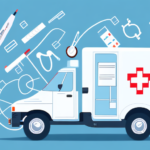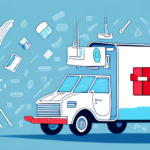How to Start a Medical Delivery Service: A Step-by-Step Guide
If you're interested in starting your own medical delivery service, you're probably wondering where to begin. This guide will walk you through all the necessary steps to start your business from scratch. From conducting market research to developing a business plan, this article will cover everything you need to know to ensure your success.
Understanding the Medical Delivery Service Industry
Before diving into the logistics of starting a medical delivery service, it's essential to understand the industry you're entering. Medical delivery services are in high demand, especially with the increasing popularity of home healthcare. The industry is also heavily regulated, and compliance with healthcare regulations is crucial. Knowing these basics will help you set realistic expectations for your business.
One of the key factors driving the growth of the medical delivery service industry is the aging population. According to the U.S. Census Bureau, the population of adults aged 65 and older is projected to nearly double by 2060. This demographic shift increases the need for medical services and supplies, creating significant opportunities for medical delivery services to provide timely and efficient delivery of these products to patients' homes.
Another important trend in the industry is the use of technology to improve delivery services. Many medical delivery companies are investing in advanced tracking and monitoring systems to ensure that deliveries are made on time and that products are handled safely and securely. This technology also allows for real-time communication between delivery drivers and healthcare providers, which can help to improve patient outcomes and reduce the risk of errors.
Market Growth and Projections
The global medical courier services market is expected to grow at a compound annual growth rate (CAGR) of X% from 2023 to 2028, reaching an estimated value of $XX billion by 2028 (Grand View Research). This growth is driven by factors such as the increasing demand for home healthcare services and advancements in medical transportation technologies.
Conducting Market Research for Your Medical Delivery Service
The next step to starting a medical delivery service is to conduct market research. This involves identifying the needs of your target market and gauging the competition. Some of the factors you need to consider when conducting market research include population demographics, payer mix, and referral sources. With this information, you'll be able to determine whether your business is viable and profitable.
It's important to note that market research is an ongoing process. As your medical delivery service grows and evolves, you'll need to continue gathering information about your target market and competitors. This will help you stay ahead of the curve and make informed decisions about your business strategy. Additionally, you may want to consider conducting surveys or focus groups to gather feedback from your customers and improve your services.
Identifying Target Markets
Determine which segments of the population you will serve, such as elderly patients, individuals with chronic illnesses, or healthcare facilities requiring regular deliveries. Understanding the specific needs of these groups will allow you to tailor your services effectively.
Analyzing Competitors
Evaluate existing medical delivery services in your area to understand their strengths and weaknesses. This analysis will help you identify gaps in the market that your business can fill.
Choosing a Legal Structure for Your Medical Delivery Business
After conducting market research, you'll need to decide on the legal structure for your medical delivery business. Some of your options include sole proprietorship, partnership, limited liability company (LLC), and corporation. Each has its advantages and disadvantages, and it's essential to consider each carefully before making a decision. Additionally, you'll need to register your business with your state and obtain an Employer Identification Number (EIN) from the IRS.
One important factor to consider when choosing a legal structure for your medical delivery business is liability. As a sole proprietor, you are personally responsible for any debts or legal issues that arise. However, with an LLC or corporation, your personal assets are protected, and the business is responsible for any liabilities. This can provide peace of mind and protect your personal finances.
Another consideration is taxes. Each legal structure has different tax implications, and it's important to understand how your business will be taxed. For example, a sole proprietorship is taxed as personal income, while an LLC can choose to be taxed as a partnership or corporation. Consulting with a tax professional can help you make an informed decision.
Getting the Required Permits and Licenses
Medical delivery services are highly regulated, and you'll need to obtain the necessary permits and licenses to operate legally. This includes obtaining a Drug Enforcement Administration (DEA) registration, State Medical Board approval, and Medical Waste Transporter licensing. Additionally, you'll need to comply with HIPAA regulations, which govern patient privacy and confidential health information. Ensuring compliance with all regulations will protect your business from penalties and lawsuits.
The requirements for permits and licenses may vary depending on the state or region where you plan to operate. Some states may require additional certifications or permits, such as a Commercial Driver's License (CDL) or a Hazardous Materials (HAZMAT) endorsement. It's crucial to research and understand all the necessary requirements before starting your medical delivery service to avoid any legal issues or delays in obtaining the required permits and licenses.
Key Regulatory Bodies
Developing a Business Plan for Your Medical Delivery Service
A business plan is an essential tool that outlines your goals, strategies, and financial projections. Having a well-written business plan not only helps you secure financing but also guides your operations and decision-making. This plan should include your mission statement, target market, marketing strategies, financial projections, and risk management strategies.
When developing a business plan for your medical delivery service, it is important to consider the legal and regulatory requirements of the healthcare industry. This includes obtaining the necessary licenses and permits, complying with HIPAA regulations, and ensuring that your staff is properly trained and certified. Additionally, you should consider the potential impact of changes in healthcare policies and regulations on your business and have contingency plans in place to adapt to these changes.
Components of a Strong Business Plan
- Executive Summary: An overview of your business and its objectives.
- Market Analysis: Insights from your market research.
- Organization and Management: Your business structure and management team.
- Service Offerings: Detailed descriptions of your services.
- Marketing and Sales Strategy: How you plan to attract and retain customers.
- Financial Projections: Revenue, expenses, and profitability forecasts.
- Funding Request: If seeking investment, detail the funds needed and their intended use.
Raising Capital for Your Medical Delivery Business
Raising capital is a critical aspect of starting a medical delivery business. Depending on the size and scope of your operations, you may need a significant investment to cover start-up costs, including purchasing vehicles and equipment, leasing a warehouse, and hiring employees. Some financing options to consider include loans, grants, crowdfunding, and partnerships.
One important factor to consider when raising capital for your medical delivery business is the potential return on investment for your investors. You will need to demonstrate how your business model is sustainable and profitable in the long term. This may involve creating a detailed business plan and financial projections to show potential investors.
Another option to consider is seeking out strategic partnerships with healthcare providers or insurance companies. These partnerships can provide not only financial support but also access to a network of potential clients and customers. Additionally, partnering with established companies in the healthcare industry can lend credibility to your business and increase your chances of success.
Financing Options
- Small Business Loans: Available through banks and credit unions.
- Grants: Government or private grants for healthcare businesses.
- Crowdfunding: Platforms like Kickstarter or GoFundMe.
- Angel Investors: Individuals who invest in startups.
Setting up Your Medical Delivery Service Office and Warehouse
Once you've secured financing, it's time to set up your medical delivery service office and warehouse. This includes purchasing or leasing a commercial space, equipping it with office equipment and supplies, and installing appropriate security measures. You'll need to ensure that your warehouse is equipped with a temperature-controlled storage area, security systems, and ventilation systems to maintain the integrity of the products you're transporting.
It's also important to consider the layout of your warehouse and office space. You'll want to create a clear and efficient workflow for your employees, with designated areas for receiving, sorting, and storing medical supplies. Additionally, you may want to invest in a tracking system to monitor the location and status of your deliveries in real-time. This can help you optimize your delivery routes and ensure timely and accurate deliveries to your clients.
Essential Equipment and Systems
- Temperature-controlled storage units
- Advanced security systems
- Inventory management software
- Real-time tracking systems
Purchasing Vehicles for Your Medical Delivery Business
Investing in reliable and efficient vehicles is critical for any medical delivery business. You'll need to purchase or lease vans or trucks with temperature-controlled compartments to maintain the integrity of the products you're transporting. You'll also need to ensure that your vehicles are adequately insured and maintained to avoid costly breakdowns and delays.
When selecting vehicles for your medical delivery business, it's important to consider the size and capacity of the vehicle. You'll need to ensure that the vehicle can accommodate the volume of products you'll be transporting, while also being fuel-efficient to keep costs down. Additionally, you may want to consider vehicles with GPS tracking capabilities to monitor the location and status of your deliveries in real-time.
Another factor to consider when purchasing vehicles for your medical delivery business is the safety features of the vehicle. Look for vehicles with advanced safety features such as lane departure warnings, blind-spot monitoring, and automatic emergency braking. These features can help reduce the risk of accidents and ensure the safety of your drivers and the products they're transporting.
Vehicle Maintenance and Safety
- Regular maintenance schedules
- Comprehensive insurance coverage
- Driver training programs
- Safety feature installations
Recruiting and Training Staff for Your Medical Delivery Team
Your staff is the backbone of your medical delivery service, and recruiting and training the right people is crucial. You'll need to create job descriptions, advertise open positions, and conduct interviews to hire qualified individuals. Additionally, you'll need to provide comprehensive training on HIPAA regulations, customer service, safe driving practices, and proper handling and transportation of medical products.
Effective Recruitment Strategies
- Utilize online job boards and local recruitment agencies
- Attend job fairs and industry events
- Offer competitive salaries and benefits
Training Programs
- HIPAA compliance training
- Customer service excellence
- Safe driving and vehicle operation
- Proper handling of medical supplies
Establishing Partnerships with Healthcare Providers and Facilities
Developing partnerships with healthcare providers and facilities is an excellent way to grow your medical delivery business. You can reach out to hospitals, clinics, rehabilitation centers, and long-term care facilities to offer your services. Building a robust network of healthcare facilities that use your service will help you establish your business in the industry and secure repeat business.
Building Relationships
- Attend healthcare industry conferences and networking events
- Offer introductory discounts or trial services
- Provide exceptional service to encourage word-of-mouth referrals
Collaborative Opportunities
- Joint marketing initiatives
- Integrated delivery solutions with healthcare IT systems
- Customized delivery schedules to meet facility needs
Creating a Marketing Plan for Your Medical Delivery Service
Creating a marketing plan for your medical delivery service will help you attract customers and generate revenue. You'll need to develop a branding strategy, build a website, craft informative marketing materials, and advertise your services to your target market. You should also consider using social media to engage with potential customers and build your brand.
Branding and Online Presence
- Develop a professional logo and brand identity
- Create a user-friendly website with SEO optimization
- Utilize social media platforms such as LinkedIn, Facebook, and Instagram
Marketing Strategies
- Content marketing through blogs and informative articles
- Email marketing campaigns targeting healthcare providers
- Search engine marketing (SEM) and pay-per-click (PPC) advertising
- Local advertising in healthcare facilities and community centers
Developing Standard Operating Procedures (SOPs) for Your Drivers and Staff
Standard Operating Procedures (SOPs) are critical to ensure consistent quality in your medical delivery services. You'll need to develop a set of SOPs that cover the complete process of medical delivery, including order fulfillment, package handling and transportation, and delivery completion. Additionally, you should establish protocols on how to handle emergencies or incidents.
Key Components of SOPs
- Order processing and tracking
- Temperature control protocols
- Security measures for high-value or sensitive deliveries
- Emergency response procedures
Implementation and Training
- Regular training sessions for all employees
- Continuous monitoring and updates of SOPs
- Feedback mechanisms for staff to suggest improvements
Ensuring Compliance with HIPAA Regulations
HIPAA regulations govern patient privacy and confidential health information and are essential for any medical delivery service to follow. You'll need to ensure that your staff adheres to the strictest standards and train them regularly on best practices. Compliance with HIPAA regulations will protect your business from penalties and lawsuits.
HIPAA Compliance Steps
- Conduct regular HIPAA training for all employees
- Implement secure data handling and storage practices
- Use encrypted communication channels for transmitting patient information
- Regularly audit compliance and address any gaps
Resources for HIPAA Compliance
Providing Excellent Customer Service to Patients and Healthcare Providers
Providing excellent customer service is critical for any business, but it's especially important for medical delivery services. You'll need to ensure that your staff is respectful, professional, and empathetic to patients and healthcare providers. This will result in positive feedback and referrals, which can help you grow your business.
Strategies for Outstanding Customer Service
- Prompt and reliable delivery schedules
- Clear and open communication channels
- Handling complaints and feedback professionally
- Personalized service to meet specific client needs
Measuring Customer Satisfaction
- Implementing customer satisfaction surveys
- Monitoring online reviews and feedback
- Tracking repeat business and client retention rates
Measuring and Tracking Key Performance Indicators (KPIs) of Your Medical Delivery Service
Measuring and tracking KPIs is essential for evaluating the success of your medical delivery service. You'll need to establish metrics that measure efficiency, safety, customer satisfaction, and financial performance. Regularly reviewing these KPIs will help you identify areas for improvement and make data-driven decisions to optimize your service.
Essential KPIs to Monitor
- Delivery Time: Average time taken to complete deliveries.
- Delivery Accuracy: Percentage of deliveries made without errors.
- Customer Satisfaction: Scores from customer feedback and surveys.
- Employee Performance: Metrics on driver efficiency and reliability.
- Financial Metrics: Revenue growth, profit margins, and cost management.
Tools for Tracking KPIs
- Business intelligence software like Tableau or Power BI
- Customer relationship management (CRM) systems
- Financial management tools like QuickBooks
Expanding and Scaling Up Your Medical Delivery Business
Once your medical delivery service is established, you can consider expanding and scaling up your business. You can do this by adding new services, expanding your coverage area, or acquiring competing businesses. It's essential to plan these growth strategies carefully, considering the financial and operational aspects.
Starting a medical delivery business can be a rewarding and profitable venture, but it requires careful planning and execution. By following the step-by-step guide outlined in this article, you'll be well on your way to establishing your successful medical delivery service.
Growth Strategies
- Introducing specialized delivery services, such as same-day or urgent deliveries
- Expanding to new geographic regions
- Diversifying service offerings to include additional medical supplies or equipment
- Acquiring or merging with other delivery services to increase market share
Operational Considerations for Scaling
- Ensuring your infrastructure can handle increased demand
- Maintaining quality and compliance standards during growth
- Investing in scalable technology solutions
- Hiring and training additional staff as needed




















